The stone House of Memory stands among scores of faded grey gravestones on Oakwood Cemetery’s Confederate Memorial grounds. Former UNC-System President Frank Porter Graham stood within the stone war monument on its dedication in 1935 and said, “A land with no memories is a land with no hope.”
Oakwood’s Confederate Cemetery was founded to remember those who died, not the causes they fought for, but its foundation and purpose are shrouded in the losing Confederate cause.
Following the Civil War’s end in 1865, the Ladies Memorial Association of Raleigh lobbied for $2,000 from the state of North Carolina to begin a confederate cemetery. The cemetery—now known as Oakwood in downtown Raleigh—was founded in 1867, two years after the Civil War’s end.
Plantation owner Henry Mordecai initially sold 2.5 acres to the Ladies Memorial Association for a Confederate cemetery, and eventually plantation families, including the Mordecais, gave land that now comprises the cemetery’s current 102 acres.
The cemetery was founded out of necessity as well as conflict—many Confederates laid buried beside Union soldiers at Pettigrew Hospital’s burial grounds (now Raleigh National Cemetery) a mile south of Oakwood. The Ladies Memorial Association transferred confederate bodies from Pettigrew’s cemetery as well as smaller Triangle-area gravesites, but the reason isn’t clear.
“The Confederates that were buried off Rock Quarry Road had to be disinterred,” said Robin Simonton, executive director of Oakwood Cemetery. “They were no longer able to stay in what is now a national cemetery, so [Oakwood] started to accommodate those confederates.”
Ernest Dollar, executive director of the City of Raleigh Museum and author of an upcoming book about the Triangle at the end of the Civil War, said it was Confederate—not Union—soldiers who provoked a separation of burial grounds.
“I’ve heard a lot of times that mean Yankee officers demanded that the Confederates be dug up and thrown out into the street.” Dollar said. “Research shows that it was actually Confederates who wanted to move their dead from being buried next to the Federal soldiers.”
Although the reason for excavating bodies from Pettigrew’s cemetery isn’t concrete, Oakwood’s purpose was made abundantly clear. The Ladies Memorial Association dug up graves from across the modern Triangle to memorialize in one place.
Beyond Oakwood’s core of Confederate dead originally buried at Pettigrew, bodies were relocated from Durham, Orange, Wake and Chatham counties.
“They started bringing [Confederate bodies] in from a lot of these smaller cemeteries and [those] buried on the side of the road,” Dollar said. “They cast their net pretty far and wide to pull in all these Confederates that had ended up in different places.”
The Ladies Memorial Association is as important to Raleigh’s reconstruction ideology as the cemetery itself, according to Dollar.
“These were organizations that popped up all over the South that were a way for these widows and childless mothers now to take care of all these dead confederates,” Dollar said.
Cemeteries were the physical representation of grief during the Victorian-era South after the Civil War.
“Cemeteries sort of popped up as a way for Southerners to deal with this incredibly great wave of grief that swept over them between 1861 and 65,” Dollar said.
Dollar said one out of four men of military-age in the South fought in the war, many of whom never returned. A war death was even more tragic than death by sickness during this time.
“A good death by Victorian standards was you’re laying in your sick bed, it lasts for weeks where people can come see you and pay respects,” Dollar said. “But a bad death for Victorians would be instant death or a death where your family couldn’t say goodbye and make your peace with God.”
The Civil War had a powerful effect on the South long after the war, according to Dollar.
“The shock of losing so many family members shattered the moral and psychological standing that many southerners had,” Dollar said. “This whole memorial aid association was a way from them to deal with that grief.”
Today, Confederate memorials such as Oakwood’s serve a purpose beyond politics of the time, according to Dollar and Simonton.
“These were just people, and they got caught up in this great political debate,” Dollar said.
Simonton said that above all, viewers should respect the Confederate Cemetery because of the men who died, not the cause.
“I know we all agree that slavery was a horrendous time period for America,” Simonton said. “What’s important when you come to Oakwood and go to a Confederate memorial anywhere is truly the boys who put their lives on the line and those who did not come home.”
Regardless of Confederate contempt, Oakwood’s Confederate Cemetery stands as a testament to North Carolina’s Civil War history.
“I value this type of place because this is not only an active burial ground, but where people come to learn about their past and the past of their community,” Simonton said.








